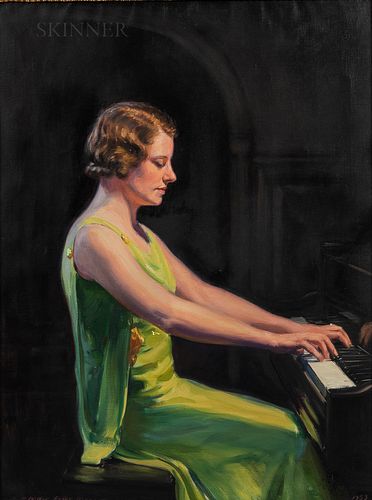Wilbur Fiske Noyes (American, 1897-1951), Portrait of the Pianist Ethel Hutchinson Russell (1897-1995)
Lot 43
About Seller
Bonhams Skinner
274 Cedar Hill Street
Marlborough, MA 01752
United States
Founded over four decades ago, Bonhams Skinner offers more than 60 auctions annually. Bonhams Skinner auctions reach an international audience and showcase the unique, rare, and beautiful in dozens of categories, including the fine and decorative arts, jewelry, modern design, musical instruments, sc...Read more
Estimate:
$1,000 - $1,500
Absentee vs Live bid
Two ways to bid:
- Leave a max absentee bid and the platform will bid on your behalf up to your maximum bid during the live auction.
- Bid live during the auction and your bids will be submitted real-time to the auctioneer.
Bid Increments
| Price | Bid Increment |
|---|---|
| $0 | $10 |
| $100 | $25 |
| $500 | $50 |
| $1,000 | $100 |
| $3,000 | $250 |
| $5,000 | $500 |
| $10,000 | $1,000 |
| $30,000 | $2,500 |
| $50,000 | $5,000 |
| $100,000 | $10,000 |
| $300,000 | $25,000 |
| $500,000 | $50,000 |
| $1,000,000 | $100,000 |
About Auction
By Bonhams Skinner
May 25, 2022
Set Reminder
2022-05-25 10:00:00
2022-05-25 10:00:00
America/New_York
Bidsquare
Bidsquare : American Art
https://www.bidsquare.com/auctions/skinner/american-art-9353
Join us in Marlborough on Wednesday, May 25th at 10:00 AM for a live auction of American Works of Art, including painting, sculpture, and works on paper. Bonhams Skinner bidsquare@bonhamsskinner.com
Join us in Marlborough on Wednesday, May 25th at 10:00 AM for a live auction of American Works of Art, including painting, sculpture, and works on paper. Bonhams Skinner bidsquare@bonhamsskinner.com
- Lot Description
Wilbur Fiske Noyes (American, 1897-1951)
Portrait of the Pianist Ethel Hutchinson Russell (1897-1995)
Signed "-Wilbur Fiske Noyes-" lower left, dated "1933" lower right, inscribed "Ethel Hutchinson Russell/Newton Mass/Artist Pupil of Heinrich Gebhard" on the reverse.
Oil on canvas, 40 x 30 in. (101.5 x 76.5 cm), framed.
Condition: Abrasion with paint loss lower center, scattered tiny paint losses, minor canvas bulge to center, slight canvas rippling to upper right corner, uneven varnish surface to lower right corner, minor surface grime.
N.B. This dramatic woman in green was known professionally as Ethel Hutchinson, a celebrated concert pianist and esteemed instructor, trained at the Royal Academy of Music in London. In Boston, she was one of a handful of
talented students accepted by Heinrich Gebhard, pianist, composer, and Boston Symphony Orchestra soloist. At that moment, Gebhard took only two artist-pupils at a time, and Miss Hutchinson's fellow apprentice was Leonard Bernstein. Hutchinson was a soloist with the Boston Pops Orchestra and the Philadelphia Symphony Orchestra. She appeared frequently in Boston's Symphony Hall and Jordan Hall. One of her last public appearances was the performance of Rachmaninoff's Second Piano Concerto with the Boston Pops Orchestra in 1947. In 1953 she collaborated with her mentor Heinrich Gebhard to make a vinyl recording of Martin Loeffler's A Pagan Poem for which Gebhard created the arrangement for two pianos.Condition
Condition: Framed dimensions are 44 x 34 x 1 1/2 inches.
The lower right corner shows a spray pattern of some foreign substance on the surface. The bulge mentioned above is due to a small bump from the reverse and is located in the background above the sitter's left arm. The abrasion with paint loss is irregular in shape and measures about 1/2 x 3/8 inches overall.
Any condition statement is given as a courtesy to a client, is only an opinion and should not be treated as a statement of fact. Skinner Inc. shall have no responsibility for any error or omission. The absence of a condition statement does not imply that the lot is in perfect condition or completely free from wear and tear, imperfections or the effects of aging. - Shipping Info
-
Please visit http://www.skinnerinc.com/services/payment-and-shipping/ for information regarding the collection of items purchased at auction.
-
- Buyer's Premium



 EUR
EUR CAD
CAD AUD
AUD GBP
GBP MXN
MXN HKD
HKD CNY
CNY MYR
MYR SEK
SEK SGD
SGD CHF
CHF THB
THB















